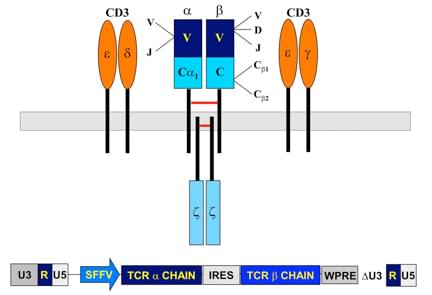All products and services are For Research Use Only and CANNOT be used in the treatment or diagnosis of disease.
Creative Biolabs offers lentivirus-mediated gene transfer services for the generation of TCR-modified T cells. Lentivirus can effectively integrate its constructed exogenous genes into the genome of various cell types including cytotoxic T lymphocytes (CTLs) and peripheral blood lymphocytes (PBLs), which makes itself an attractive tool for engineering T cells. Several researches have confirmed the safety of lentiviral vectors as they do not increase the mutation or tumor incidence. We provide various lentiviral vectors to meet every customer`s requirement.

Figure: A scheme of TCR and a lentiviral vector co-expressing α and β TCR chains.
T lymphocytes play crucial roles in immunity, there are various gene therapy strategies targeting T cells. And the efficient gene transfer into T cells facilitates the treatment of several genetic dysfunctions, inherited diseases and acquired diseases, etc. In recent years, this strategy has also been proven to be an alternative solution for many diseases such as hemophilia, adenosine deaminase deficiency (ADA) and chronic granulomatous disease (CGD). In order to achieve a long-term gene transfer, various tools and methods are developed and researched. Among which, lentiviral vectors, derived from HIV-1, have shown promise to tansduce various cell types including some resting cell types. Lentiviral vectors allow mitosis-independent nuclear import of the preintegration complex, which make them preferred gene packaging & delivery vectors for transduction of nonproliferating cells. There are mainly three types of strategies that are used to target lentiviral vectors-mediated to a given cell type or tissue. The first strategy is transductional targeting which is achieved by the modification of the vector surface. And the modification of vector surface can be performed by the incorporation of foreign envelope glycoproteins having a natural restricted tropism or the inclusion of specific ligands fused to the envelope proteins that will determine the affinity of the vector for a given target cell. The second strategy is transcriptional targeting that relies on the insertion of a tissue-specific promoter, or a fragment of this promoter, upstream of the therapeutic transgene. The third one is a novel method combining the microRNA (miRNA) post-transcriptional regulation with lentiviral technology.
With rich experience, Creative Biolabs will offer safe and well controlled expression systems used in TCR gene transfer.
The most popular strategies used for TCR gene transfer:
| ➤ | Viral vectors: |
Retroviral vectors Lentiviral vectors |
| ➤ | Electroporation |
References:
To discuss your demands or to request a proposal, please contact us by .
For any technical issues or product/service related questions, please leave your information below. Our team will contact you soon.
 NEWSLETTER
NEWSLETTER
The latest newsletter to introduce the latest breaking information, our site updates, field and other scientific news, important events, and insights from industry leaders
LEARN MORE NEWSLETTER NEW SOLUTION
NEW SOLUTION
CellRapeutics™ In Vivo Cell Engineering: One-stop in vivo T/B/NK cell and macrophage engineering services covering vectors construction to function verification.
LEARN MORE SOLUTION NOVEL TECHNOLOGY
NOVEL TECHNOLOGY
Silence™ CAR-T Cell: A novel platform to enhance CAR-T cell immunotherapy by combining RNAi technology to suppress genes that may impede CAR functionality.
LEARN MORE NOVEL TECHNOLOGY NEW SOLUTION
NEW SOLUTION
Canine CAR-T Therapy Development: From early target discovery, CAR design and construction, cell culture, and transfection, to in vitro and in vivo function validation.
LEARN MORE SOLUTION